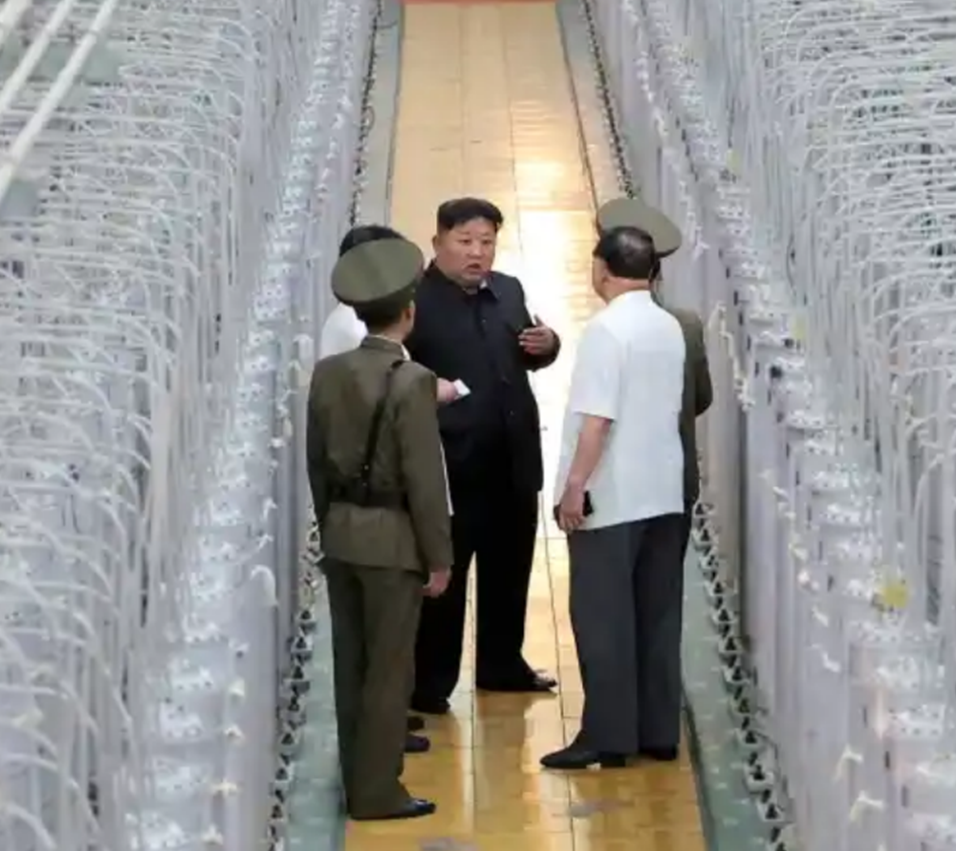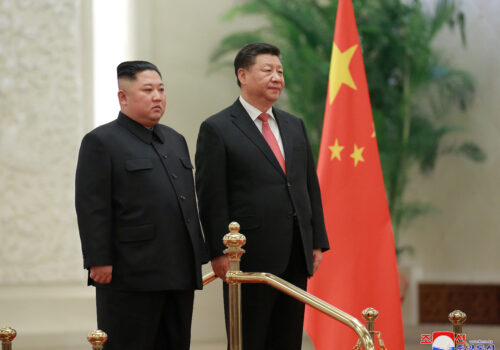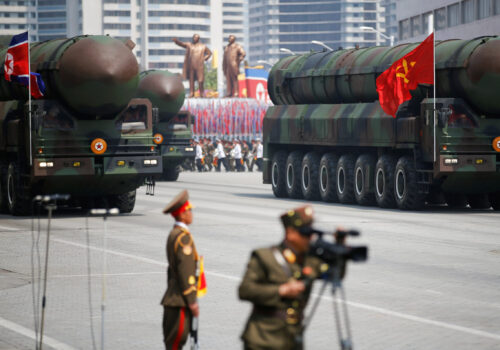New presidents and new nuclear developments test the United States–Republic of Korea alliance
Key takeaways
- South Korea’s new President, who will be elected on June 3, will have to grapple with many South Koreans’ unease with relying on the United States’ nuclear arsenal for deterring North Korea.
- The first and most important test the US-South Korea alliance under Trump and the incoming new South Korean president faces is the continuing growth of North Korea’s nuclear and ballistic missile capabilities.
- South Korea’s establishment of a new strategic command outside of the combined US-ROK military structure highlights Seoul’s willingness and capability to take greater responsibility for deterring North Korea, but careful coordination will be required to ensure this strengthens rather than strains the alliance.

In the coming years, the US-South Korea (Republic of Korea, or ROK) alliance is likely to be tested in at least three fundamental ways: by a concerning growth in North Korea’s nuclear and ballistic missile weapons program; by changes to ROK defense capabilities and structures, including the establishment of ROK Strategic Command (ROKSTRATCOM); and by potential strategy and policy changes under new US and ROK political administrations.
Though the alliance may rise to the challenges of these tests to emerge stronger, these factors could potentially prevent the United States and the Republic of Korea from leveraging the mutual benefits that come from being integrated into a unified wartime command system and the long-standing ideal of a US-ROK bilateral agreement that emphasizes mutual defense. The United States will need to continue to adapt its approach, account for its ally’s perspectives, and plan for the inevitable change to the status quo on the Korean Peninsula.
A second North Korean enrichment facility heightens security concerns in Seoul
The first test for the alliance is the continuing growth of North Korea’s nuclear and ballistic missile programs. Current estimates suggest Pyongyang has enough fissile material to build up to 90 nuclear warheads, which generates compelling security concerns that could create tension among two longtime and staunch allies—the United States and the Republic of Korea. North Korean leader Kim Jong Un has placed increasing importance on the regime’s nuclear weapons development in the last decade, portraying nuclear weapons as not only defensive but providing the means to win in conflict. In September 2022, North Korea promulgated a new law that laid out a much broader approach to the use of nuclear weapons, including their employment in various conditions.
In 2023, Kim updated Article 58 of the state’s constitution to “ensure the country’s right to existence and development, deter war and protect regional and global peace by rapidly developing nuclear weapons to a higher level.” In September 2024, North Korean state media released photos for the first time of a suspected second uranium enrichment facility and Kim called for a higher number of more capable centrifuges to boost his plans to “exponentially” increase nuclear warhead production. Further, 2025 marks the final year for Kim to achieve the military capability development goals laid out in his five-year plan.

North Korea has a nuclear dyad with land- and sea-based nuclear weapons, and it is developing new technologies, including hypersonic gliding flight warheads and multiple independently targetable reentry vehicles, consistent with Kim’s drive to rapidly develop nuclear weapons and the five-year plan. North Korea’s Strategic Forces have short-range, medium-range, intermediate-range, and intercontinental ballistic missiles (ICBMs), along with 200 road-mobile launchers. North Korea’s continued development of its rail-based ballistic system shows the regime’s efforts to diversify launch platforms, including various vehicles and ground launch pads and potentially submarines, and increase the survivability of its force. While Kim’s ability to strike the US homeland with North Korean ICBMs only grows with additional testing and the introduction and testing of its solid-fuel ICBM in 2023, the regime is also hard at work improving the efficacy of its precision-guided tactical nuclear weapons, which are designed to significantly damage South Korea and US forces on the peninsula, as well as create response challenges for the alliance.
In addition, North Korea is moving forward on its sea-based deterrent. It has ballistic missiles and what it terms ”strategic” (alluding to long range and nuclear capability) cruise missiles for both developmental, missile-firing submarines and underwater platforms. Its tactical nuclear attack submarine, the Hero Kim Kun Ok, is designed to launch tactical nuclear weapons from underwater. In January 2024, the regime tested its underwater unmanned nuclear weapon system, the Haeil-5-23, as a purported response to the trilateral US-ROK-Japan maritime exercise. In January 2025, the regime tested an underwater-to-surface strategic guided cruise missile while also vowing to respond to the United States with the “toughest counteraction.”
Ultimately, North Korea wants to halt US-ROK joint (and multinational) military exercises and to splinter an alliance of seventy-plus-years between the two nations. Its determined and bellicose approach has the potential to highlight the asymmetry of what’s at stake between the United States and the ROK and, if unchecked, sow fear and doubt into the fabric of the alliance.
Would South Korea go nuclear? A shift in ROK defense architecture
The second test of the alliance follows changes in the ROK’s defense architecture and capabilities, including the advent of the ROK Strategic Command (ROKSTRATCOM), which may increase potential areas for divergence among allies even as the changes show the ROK’s increasing capability and willingness to take greater responsibility for its own defense. ROKSTRATCOM’s establishment may be an opportunity rather than just a challenge and it is perhaps more a response to an increasingly serious threat from North Korea than a shortfall in the US-ROK alliance. It nevertheless highlights that South Koreans may not feel US extended deterrence guarantees are sufficient given the growing North Korean threat.
Plans to establish ROKSTRATCOM were underway for over two years by the time of the command’s official establishment on October 1, 2024, yet many Americans either did not pay attention or believe there was a need for such a command on the Korean Peninsula. After all, the United States, South Korea’s strongest ally, has been with the ROK since the Korean War began in 1950. The two countries also have a long-standing Mutual Defense Treaty, signed shortly after the Korean War Armistice. So, for some observers, South Korea’s need for such a command was questionable. The United States already commits to defending South Korea, most visibly with 28,500 military personnel present on the peninsula and contributing to the Combined Forces Command, US Forces Korea, and the United Nations Command. Regular joint exercises and strategic activities, such as a port visit of the USS Kentucky ballistic missile submarine to Busan, also bolster this presence.

Importantly, though, ROKSTRATCOM does not clearly fall under the combined alliance wartime command construct under a bi-national Combined Forces Command that has been in place since 1978. ROKSTRATCOM is instead an independent ROK-controlled command, currently led by ROK Air Force Lieutenant General Jin Young Seung, and it is still under development exactly how this new command will align and coordinate with CFC and other alliance constructs like the bilateral Military Committee.

Operationally, ROKSTRATCOM resides under the ROK Joint Chiefs of Staff, serving as an integrator of ROK armed forces’ strategic weapons systems from each military branch. In July 2024, a former ROK minister of defense expressed the administration’s vision of the command:
The strategic command will be a unit that leads the development of nuclear and conventional integrated operational concepts and plans and combat development in new areas such as space, cyber, and the electromagnetic spectrum in conjunction with the operation of the ROK-US Nuclear Consultative Group (NCG).
According to a news report citing the South Korean Ministry of National Defense, the command “would also give the orders to subordinate military assets to strike enemy targets or intercept hostile missiles as part of the Kill Chain strategy and the Korea Massive Punishment and Retaliation [KMPR] plan.” (See the ministry’s 2022 white paper for more information about the kill chain strategy and the KMPR plan.)
It is more than just command and control that is changing, however. South Korea’s independent strike capabilities are increasing. South Korea unveiled its most powerful conventional weapon, the Hyunmoo-5, referring to it as an “ultra-high-power ballistic missile.” The high-yield Hyunmoo-5 appears to be intended as a ROKSTRATCOM capability, integral to reinforcing ROK messages of an “overwhelming response” to any North Korea nuclear attack. It remains to be seen, however, how the command will contribute these forces to a conflict on the Korean Peninsula—and this calls into question the previously relied upon unified command system.
The establishment of ROKSTRATCOM is a historic event and time will tell if capabilities breed intentions. It appears South Korea is not willing to take the option of having nuclear weapons off the table despite the US nuclear umbrella and extended deterrence commitments. As the ROK continues to grapple with its current and future defense challenges, the United States should take care to be an integral part of this ROK process, thereby ensuring a better understanding of the intentions of allies, enhancing the alliance, and deterring North Korea from strategic attack.
New presidents in Washington and Seoul portend policy changes
The third test involves expected changes by the new Trump administration to US policies and strategies affecting the alliance, along with potential adjustments by the imminent new South Korean administration to its approach toward the alliance and to defense issues more broadly. Coupled with divisive domestic politics in both the United States and South Korea, these developments could potentially open old wounds and create new points of contention within the alliance. As the new US administration begins to set its tone for foreign policy for the rest of its term, many South Koreans seem hopeful, but uncertain. Meanwhile, South Korean media reports and commentaries are examining the implications of rumored US force reductions in Korea and other potential changes to US policy and strategy affecting the alliance as either challenges or opportunities.
South Korea will soon have its own new president, after the martial law declaration by Yoon and his removal from office resulted in elections set for June 3. A new ROK president may well inject more uncertainty into the state of South Korean affairs, which could affect the alliance, as the country works to self-heal from Yoon’s surprising martial law announcement and the subsequent fallout.
Meanwhile, there are lingering questions about whether South Korea will eventually develop its own nuclear weapons. While many Americans empathize with South Korea’s undesirable position, its creation of ROKSTRATCOM and varied calls by ROK officials for nuclear weapons are concerning for US assurance efforts and, potentially, its nonproliferation policy. Would South Korea really go nuclear? Given the tense nuclear-armed neighborhood that surrounds the small country, and North Korea’s continued refusal to give up its nuclear weapons, many ask, “Why not?” Others, however, argue South Korea “cannot” or would “never” do so because it is a signatory of the Treaty on the Non-Proliferation of Nuclear Weapons (NPT). However, the NPT has a get-out-of-jail free card in Article X. According to a 2005 Arms Control Today article by the late arms control experts George Bunn and John B. Rhinelander:
Article X of the NPT provides a “right” to withdraw from the treaty if the withdrawing party “decides that extraordinary events, related to the subject matter of this [t]reaty, have jeopardized the supreme interests of its country.” It also requires that a withdrawing state-party give three months’ notice.
South Korean public discussion of a nuclear latency capability and indigenous nuclear weapons has been growing, with some officials publicly expressing the desire to keep the option open or to actually build nuclear weapons. Most recently, the People Power Party presidential candidate, Kim Moon Soo, announced that, if elected, he would pursue a nuclear latency capability—meaning that South Korea would be much closer to being able to build nuclear weapons on short notice. This indicates South Korea’s unease with relying on the United States as the only nuclear weapons responder to a growing North Korean nuclear arsenal.
Conclusion
These new hurdles—a more capable and threatening nuclear North Korea; a shift in South Korea’s defense architecture, including a unilateral strategic command; and presidential-level political changes—will inevitably strain the alliance, but may also present opportunities. The US-ROK alliance has remained ironclad, with more than seven decades of experience and adaptation, underpinned by a commitment to each other’s mutual defense. Now it is up to both countries to learn from their past while developing new approaches to the changing status quo. No matter who wins the ROK presidential election, the continued strength of the US-ROK alliance matters in the face of threats confronting both the United States and South Korea. Early and in-depth engagement by Washington with the new South Korean president to begin charting a new course for the alliance will ensure the US-ROK alliance emerges even stronger and more equipped to enhance each country’s interests, as well as underpin stability in the region.
About the authors
Heather Kearney is a nonresident fellow in the Indo-Pacific Security Initiative at the Atlantic Council’s Scowcroft Center for Strategy and Security. She is also a senior Indo-Pacific analyst in the Joint Exercise, Training, and Assessments Directorate at United States Strategic Command. As a senior analyst for risk of strategic deterrence failure, she leads a team dedicated to assessing trends in the environment in order to inform strategic risk assessments.
Amanda Mortwedt Oh is a USSTRATCOM liaison officer in the Office of Strategic Deterrence and Nuclear Policy, Strategic Stability, in the Joint Staff J-5 Directorate. She focuses her research on Northeast Asia and strategic deterrence and was most recently a Fall 2024 Nonproliferation Policy Education Center Policy Fellow. She is the previous director of international outreach and development at the Committee for Human Rights in North Korea (HRNK) and has published several articles and reports on North Korea’s prison camps and human rights issues. She is also a lawyer in the US Army Reserve Judge Advocate General’s Corps.
Disclaimer: The views presented in this article are those of the authors and do not necessarily represent the views of US Strategic Command, the US Air Force, the Department of Defense, or the US government.
The Tiger Project, an Atlantic Council effort, develops new insights and actionable recommendations for the United States, as well as its allies and partners, to deter and counter aggression in the Indo-Pacific. Explore our collection of work, including expert commentary, multimedia content, and in-depth analysis, on strategic defense and deterrence issues in the region.
Related content
Explore the program

The Indo-Pacific Security Initiative (IPSI) informs and shapes the strategies, plans, and policies of the United States and its allies and partners to address the most important rising security challenges in the Indo-Pacific, including China’s growing threat to the international order and North Korea’s destabilizing nuclear weapons advancements. IPSI produces innovative analysis, conducts tabletop exercises, hosts public and private convenings, and engages with US, allied, and partner governments, militaries, media, other key private and public-sector stakeholders, and publics.
Image: Large-scale Korea-US joint landing exercise on March 16, 2016. Released by the Republic of Korea Armed Forces.



